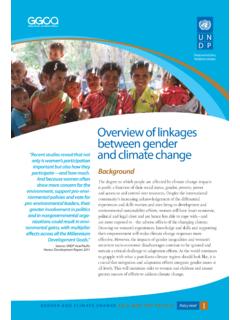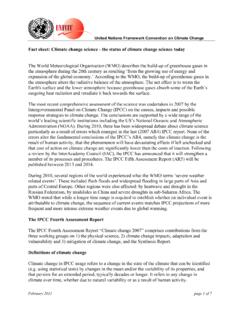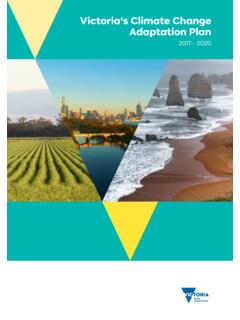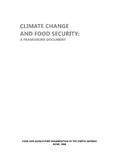Transcription of Climate change adaptation and mitigation - fao.org
1 Climate change . adaptation AND. mitigation . CHALLENGES AND OPPORTUNITIES IN. THE FOOD SECTOR. I 2 4 8 0 E / 1 / 11 . 11. JOBNUMBER TO BE INSERTED HERE, PLEASE. Climate change . adaptation AND. mitigation . CHALLENGES AND OPPORTUNITIES IN. THE FOOD SECTOR. Food and Agriculture Organization of the United Nations (FAO). Natural Resources Management and Environment Department Rome, September 2012. This publication reproduces one of the discussion papers of the High-Level Conference on World Food Security: the Challenges of Climate change and Bioenergy, FAO, Rome, Italy, 3-5 June 2008 ( ). Should this study be revisited today, the author would define the implementation periods as follows: short term would be up to 2015, which is the time the international community requires for new Climate agreements; medium term would be from 2015 to 2020, which is the run-up to the beginning of the new rules, as well as to implementation and to taking further the future role of agriculture in Climate agreements; long term would be beyond 2020, which is the time for full implementation of the new rules, including the role of agriculture.
2 Tubiello, F. 2012. Climate change adaptation and mitigation : challenges and opportunities in the food sector. Natural Resources Management and Environment Department, FAO, Rome. Prepared for the High-level conference on world food security: the challenges of Climate change and bioenergy, Rome, 3-5 June 2008. The designations employed and the presentation of material in this information product do not imply the expression of any opinion whatsoever on the part of the Food and Agriculture Organization of the United Nations (FAO) concerning the legal or development status of any country, territory, city or area or of its authorities, or concerning the delimitation of its frontiers or boundaries. The mention of specific companies or products of manufacturers, whether or not these have been patented, does not imply that these have been endorsed or recommended by FAO in preference to others of a similar nature that are not mentioned.
3 The views expressed in this information product are those of the author(s) and do not necessarily reflect the views of FAO. All rights reserved. FAO encourages the reproduction and dissemination of material in this information product. Non-commercial uses will be authorized free of charge, upon request. Reproduction for resale or other commercial purposes, including educational purposes, may incur fees. Applications for permission to reproduce or disseminate FAO copyright materials, and all queries concerning rights and licences, should be addressed by e-mail to or to the: Chief, Publishing Policy and Support Branch Office of Knowledge Exchange, Research and Extension FAO. Viale delle Terme di Caracalla 00153 Rome, Italy FAO 2012.
4 Cover photo: FAO/Munir Uz Zaman Climate change adaptation AND mitigation : CHALLENGES AND OPPORTUNITIES IN THE FOOD SECTOR. TABLE OF CONTENTS. v ACRONYMS. 1 INTRODUCTION. 2 Increased and new vulnerabilities 4 Agriculture and global Climate change 6 adaptation and mitigation strategies 7 Global challenges and key persperctives 9 Climate responses and food security 11 LINKING adaptation AND mitigation WITHIN Climate POLICY. MECHANISMS. 12 POLICY AND TECHNOLOGY REQUIREMENTS. 12 Expanding the role of adaptation and mitigation within development policies 12 Data, research and operational requirements 15 Changing the decision environment 17 POLICY OPTIONS. 17 Short-term (current to 2012). 18 Medium-term (current to 2020-2030) 19 Longer term (current to 2050 and beyond).
5 20 GLOSSARY OF TERMS. 21 REFERENCES. iii Climate change adaptation AND mitigation : CHALLENGES AND OPPORTUNITIES IN THE FOOD SECTOR. List of tables and boxes Box 1. 3 Key impacts of Climate change Box 2. 8 adaptation strategies in agriculture Box 3. 9 Synergies in adaptation and mitigation Box 4. 14 Actions needed to facilitate adaptation responses Box 5. 16 Barriers to mitigation Table 1. 5 Anthropogenic greenhouse gas emissions Table 2. 6 mitigation potential in agriculture and forestry in 2030. iv Climate change adaptation AND mitigation : CHALLENGES AND OPPORTUNITIES IN THE FOOD SECTOR. ABBREVIATIONS AND ACRONYMS. A/R Afforestation and Reforestation CDM Clean Development Mechanism CGIAR Consultative Group on International Agricultural Research FR Forest Restoration IPCC Inter-Governmental Panel on Climate change MDGs Millenium Development Goals REDD Reducing Emissions from Deforestation and forest Degradation SFM Sustainable Forest Management including.
6 UNFCCC United Nations Framework Convention on Climate change v Climate change adaptation AND mitigation : CHALLENGES AND OPPORTUNITIES IN THE FOOD SECTOR. vi Climate change adaptation AND mitigation : CHALLENGES AND OPPORTUNITIES IN THE FOOD SECTOR. INTRODUCTION. Agriculture and the future of global food security figure very importantly in Climate change negotiations. As stated in Article II of the United Nations Framework Convention on Climate change (UNFCCC), the goal is to ensure stabilization of greenhouse gas concentrations in the atmosphere at a level that would prevent dangerous anthropogenic interference with the Climate system . Such a level, it mandates, should be achieved within a time-frame sufficient to allow ecosystems to adapt naturally to Climate change , to ensure that food production is not threatened and to enable economic development to proceed in a sustainable manner.
7 Agriculture, rural livelihoods, sustainable management of natural resources and food security are inextricably linked within the development and Climate change challenges of the twenty-first century. Indeed, not only is food security an explicit concern under Climate change ; successful adaptation and mitigation responses in agriculture can only be achieved within the ecologic, economic and social sustainability goals set forth by the World Food Summit, the Millennium Development Goals and the UNFCCC. The scope of this paper is to identify a strategy for Climate change responses in agriculture that are consistent with safeguarding food security, rural livelihoods and the provision of environmental services.
8 Special focus is given to existing and potential future mechanisms necessary to support adaptation , mitigation , technology transfer and financing at national, regional and international levels. The most important challenge for agriculture in the twenty-first century is the need to feed increasing numbers of people most of whom are in developing countries while at the same time, conserving the local and global environment in the face of limited soil and water resources and growing pressures associated with socio-economic development and Climate change . Projected population and socio-economic growth will double current food demand by 2050. To meet this challenge in developing countries, cereal yields need to increase by 40 percent, net irrigation water requirements by 40-50 percent, and 100-200 million ha of additional land may be needed, largely in sub-Saharan Africa and Latin America.
9 Food insecurity will continue to be a serious issue in coming decades. Despite significant projected overall reductions in hunger projected by the end of the century from the current 850 million to about 200-300 million many developing countries will continue to experience serious poverty and food insecurity, due to localized high population growth rates, poor socio-economic capacity and continued natural resource degradation. By the end of the century, 40 to 50 percent of all undernourished are expected to live in sub-Saharan Africa. Projections indicate that MDGs for undernourishment will not be met, despite robust projected economic 1. Climate change adaptation AND mitigation : CHALLENGES AND OPPORTUNITIES IN THE FOOD SECTOR.
10 Growth. Indeed, prevalence of hunger may indeed be halved, but not before 2030, unless additional policy measures are implemented. Climate change will superimpose itself on these existing trends, significantly increasing production risk and rural vulnerability, particularly in regions that already suffer from chronic soil and water resource scarcity, high exposure to climatic extremes including droughts and flooding, poverty and hunger (see Box 1). Climate change pressures will be compounded by a pronounced lack of sufficient knowledge, infrastructure, organization and resources that local populations and national governments need to cope with and adapt to Climate change . This will be especially true in many poor tropical arid and semi-arid regions, increasing the risk of large overall negative impacts on food security, natural resources and rural livelihoods in coming decades and further increasing the gap between developing and developed countries.


















